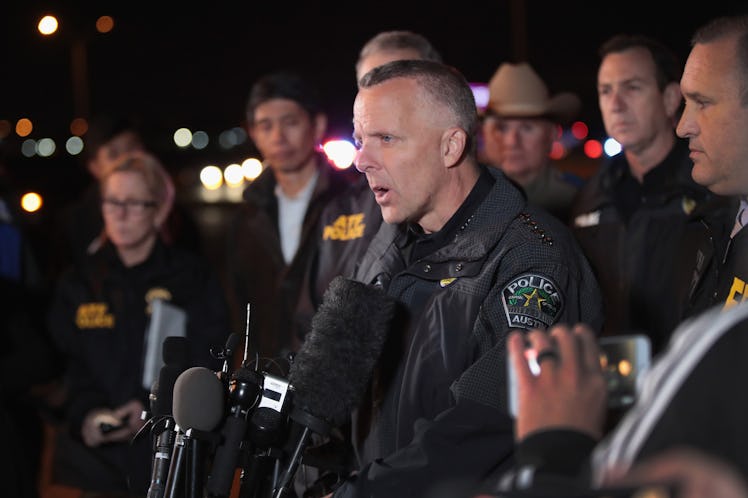
Calling The Austin Bombing Suspect “Quiet” & Not “A Terrorist” Says More Than You Realize
The cycle is well-known. After the identity of a white, suspected mass murderer is discovered, news organizations produce headlines about how unassuming of a character the suspect really was, framing a contrast between the suspects' lives and their alleged actions. The case of the Texas native suspected of having been behind a series of bombings in Austin is no different, and, because of that, media coverage of the Austin bombing suspect is raising the same old questions about racial bias.
The most notable of these headlines came from the most notable of print organizations. On Wednesday, March 21, The New York Times published a story detailing how police narrowed down their search for a suspect. The title of the article on The Times' webpage — "Lucky Breaks, Video and Pink Gloves Led to Austin Bombing Suspect" — revolved around the clues police used. But it was the caption the The Times used to share the article on Twitter that stood out the most.
"The Austin bombing suspect was a quiet, 'nerdy' young man who came from a 'tight-knit, godly family,' said Donna Sebastian Harp, who had known the family for nearly 18 years." the tweet read.
It's no secret why the framing of the tweet was loathed, either. It fits into a genre that continues to be entertained by year after year, tragedy after tragedy: The story about how the white suspect was misunderstood and wasn't really the way his alleged actions would make him seem.
This genre continues to be popular despite how redundant it is. There is, in fact, nothing surprising — nor, arguably, newsworthy — about a family member or close friend thinking the best of those close to them. And yet, testimonies from those close friends and family are constantly treated as novel, in certain cases.
Then there's the fact that there's no shortage of studies on how disproportionately news companies tend to cover black suspects and portray black families. Those studies, at the very least, give people reason to be skeptical about the news coverage afforded to white suspects.
In the case of the Austin bombing suspect, some news stories highlighted a list of targets he left behind, others highlighted how shy of person he was.
Even more head-scratching than the news coverage of the suspect was the view of Austin's police chief. Speaking at a news conference, while talking about a confession tape the suspect left behind on his phone, Chief Brian Manley said, "He does not at all mention anything about terrorism nor does he mention anything about hate. But instead it is the outcry of a very challenged young man talking about challenges in his personal life that led him to this point."
That, too — like the New York Times' tweet — drew scrutiny, for the same obvious reasons.
"Once, before I die, I'd like to hear a cop or prosecutor declare — and mainstream media report — that the confession of a black- or brown-skinned suspect to a crime of violence is 'the outcry of a very challenged young man, talking about challenges that led him to this point'" David Simon, the producer of former HBO hit series The Wire, tweeted.
"This is a remarkable level of empathy considering the whole, yanno, blowing people up thing," ESPN commentator Bomani Jones said on Twitter.
Perhaps the question isn't about whether the suspect deserves empathy, though. An even better question is why there seems to be larger capacity to show that empathy to one group of people, versus others. That question is nothing new; it's been asked for a while and gone unanswered for a while.
But every time the news covers mass murderers, they give people every reason to think the answer is the one they fear.